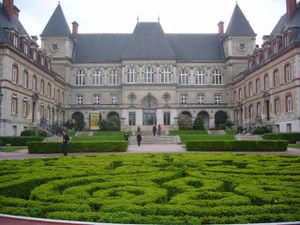Who would have thought that in Paris there is a real campus sitting on 37 ha of land? On a sunny Sunday I took the dog to Parc Montsouris to smell the green grass and on our way home I cut through the Cité Internationale Universitaire, which I knew from a previous visit but had kind of forgotten. Both parks have the great advantage of allowing dogs on the leash - the only parks in the 14th arrondissement that I know of.
Last Sunday I returned for a visit guided by an architect. The idea of creating a campus arose shortly after the end of WW1 when somebody had the idea that by putting students of different nationalities together one might be able to promote peace and understanding. As there was a flagant lack of decent student housing in Paris, the will was there - and the money, too. A rich industrialist by the name of Émile Deutsch de la Meurthe donated a big sum of money on the condition that land be found and the decision to build would be taken within 1 year. It is said that the law to create the campus was passed on the evening of the one year time limit!

The land was formerly a military area, and construction started in 1923. The first students arrived in 1925 at the Fondation Émile Deutsch de la Meurthe, a group of buildings heavily inspired by Oxford and Cambridge. There were no conditions as to the style of each house, which is why the campus, which today consists in 39 houses, I believe, has an incredible variety in style. The houses were financed by a country or region or individual donor (e.g. Adenauer, Rockefeller), and most architects tried to give a trait of the country from where the money came. The last house was finished in 1969, and then one put a stop to the construction of further buildings. Originally the plan had been for a big(ger) campus, but the construction of the Périférique in the 1950ies cut off a big part of the campus area (with one house actually now located on the other side of the Périférique). link
The houses are these days either run (and financed) by individual countries or by foundations. The rule is that a country has to allow min. 30% of students of other nationalities into their house. Over the years there have been some changes to the names of the houses. Thus The Fondation Avicenne, built in 1969, used to be the Maison d'Iran, but apparently the Iranian Shah withdrew the financing because he found that the students were working against him. The Maison des Etudients de l'Asie du Sud-Est was formerly known as the Maison de l'Indochine and was financed by French industrialists based in South-East Asia. I presume that it became politically incorrect to make reference to Indochine. Residence Lucien Paye was formerly known as Maison de la France d'Outre-Mer with clear references in the reliefs on the building to Africa, but, again, when the colonies in Africa got their independence, it was perhaps considered better to rename the building.

During the guided walk we visited four buildings: The Maison des Etudients de l'Asie du Sud-Est, the Maison d'Etudiants Armeniens, the Fondation Biermans-Lapôtre and the Maison du Maroc. We did not visit individual rooms or the showers or the kitchens, but had a peep into the official rooms/halls with their decorations from Thailand, Armenia, Morocco and Belgium. We saw students sitting in in reading rooms or playing the piano and walking to their rooms with a pot of rice. We saw cleaning ladies (black) and security personnel (black). It looked very organised and clean everywhere and not quite like my Danish student hall of residence days...... Perhaps the students are more mature when they arrive here because the rule is apparently that you have to be on a master's or PhD programme to get a room or studio flat here.
After the guided tour I went to have a look at the other houses, among which the Brazilian House drew my special attention. It was designed by Le Corbusier and is in concrete with yellow and green details. The Japanese house has big windows full of white and rosy rice lamps. The Mexican House has beautiful wall paintings. This is a gorgeous campus to go for a stroll on a sunny afternoon!
